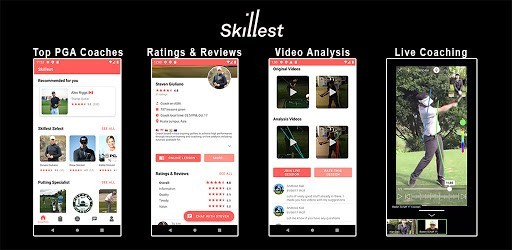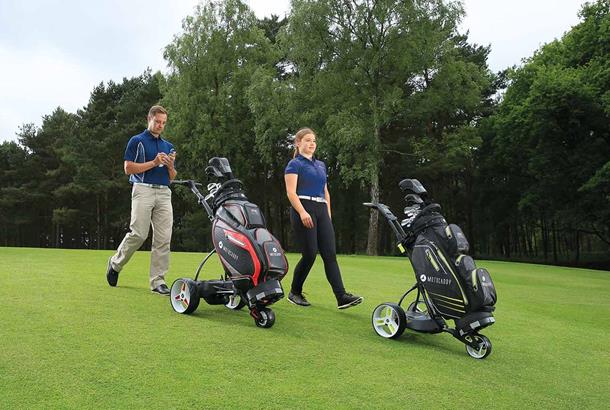How Golf Simulators Work
Ever wondered how you can play golf inside the comfort of your home or at some of the best indoor golf venues? This might have seemed impossible a few decades ago. But thanks to the advent of technology, particularly the creation of golf simulators, golfers can now play their favorite sport anytime, anywhere. In this article we will deep dive into the technology of golf simulators, you’ll find out How Golf Simulators Work and much more about golf simulators, let’s get started!

Understanding the Basics of Golf Simulators
First things first, what is a golf simulator? Simply put, a golf simulator is a high-tech system that lets you play golf indoors in a simulated environment. It’s like having a virtual golf course inside your living room or basement.
Golf simulators have been a game-changer since their inception in the 1970s. Initially, they were just a computerized golf setup designed to replicate the real game. But over the years, their technology has significantly improved. Today, they can help you analyze your swing, understand your weaknesses, and improve your game without setting foot on a real golf course.
Imagine this scenario: it’s a rainy day outside, but you’re itching to practice your swing. Thanks to golf simulators, you can do that without worrying about the weather.

The Magic Behind the Screen: Hardware and Software
How Golf Simulators Work? Like most things tech, golf simulators consist of a combination of hardware and software. The hardware includes things like cameras, radars, optical sensors, hitting mats, projectors and screens, enclosures, nets, and sound systems.
The software part is where things get really interesting. The software measures parameters such as ball speed, club speed, clubface angle, club path, spin, and launch angle, and then simulates the shot in a virtual environment.
For instance, let’s say you’re using your Driver to hit a long drive down the fairway. The software uses the data collected from the sensors to simulate the trajectory and distance of your shot, all in real-time.

Different Types of Golf Simulators
Golf simulators come in different types, mainly depending on the technology they use to track ball and club data. But How Golf Simulators Work? Some use photometric technology, which involves high-speed cameras taking images of the ball immediately after impact.
Then, there are infrared simulators that emit light signals to capture the exact position of the clubhead. Infrared simulators are great if you want to use foam or plastic balls instead of real ones.
Radar-based simulators, on the other hand, use Doppler radar technology to track the ball. These radars emit a microwave signal from the unit, which bounces back from the golf ball after impact.
To put this into perspective, think of the debate between trackman vs flightscope. Both use different technologies, but they essentially serve the same purpose – to help you get better at golf.

The Operating Process of a Simulator
If you’re wondering How Golf Simulators Work, well the process of a simulator is similar to that of a computer. When you hit the ball, the sensors, cameras, or radars pick up the data of the swing and shot. This data is then sent to the software for processing. After processing, the result is shown on the screen, giving you a real-time update on how well (or poorly) you hit the ball.
For instance, let’s say you’re practicing your irons. You take a swing and the ball soars towards the pin. The simulator takes into account your club speed, ball speed, launch angle, and spin to replicate the ball’s trajectory and landing spot.
In some cases, the software goes a step further to provide feedback. For instance, it might tell you that you’re hitting the ball too fat or that your swing path is too outside-in. It’s like having a personal coach who gives you instant feedback.

How Does Putting Work in a Golf Simulator?
Putting in a golf simulator can be slightly more challenging to measure than other shots. However, technology has come a long way to ensure accurate putting results.
High-tech sensors can measure the putt’s speed and direction, and then the software simulates how the ball would roll on a real green. Some golf simulators can even replicate the green’s slope and break, adding another layer of realism to the game.
This technology is crucial for golfers who want to practice their putting skills. After all, as any golfer knows, you drive for show, but putt for dough.

The Data Measured by Golf Simulators
Different golf simulators will measure different data sets depending on their tracking system. But at the very least, all golf simulators measure essential parameters like ball speed and distance.
More advanced systems can measure other parameters like launch angle, backspin, sidespin, and even smash factor. Some of these might seem like jargon to novice golfers, but they’re actually crucial metrics that can help you understand and improve your game.
Take for instance the swing speed. Knowing your swing speed can help you choose the right club and ball for your game. Or consider the launch angle. By understanding your launch angle, you can make necessary adjustments to your swing to maximize your distance.

The Impact of Golf Simulators on the Game
Golf simulators have had a massive impact on the game. They have not only made golf more accessible to the masses, but they have also provided an effective training tool for professional golfers.
Even top golfers like Tiger Woods, who has an estimated net worth of $800 million, use golf simulators to hone their skills.

Conclusion
Golf simulators are a testament to how far technology has come. They have revolutionized the way we practice and play golf, making the game more enjoyable and accessible. So the next time you’re stuck indoors and itching to play golf, consider getting a golf simulator. You might just find that it’s the perfect solution to improving your game.
FAQ’s: How Golf Simulators Work
How Do Golf Simulators Track the Ball?
Golf simulators use high-tech sensors, cameras, or radars to track the ball’s movement. As soon as you strike the ball, these devices capture various parameters such as the ball’s speed, launch angle, and spin. This data is then fed into the simulator’s software, which uses complex algorithms to replicate the ball’s flight path on the screen.
How Does a Golf Simulator Calculate Distance?
Distance calculation in a golf simulator is a complex process that involves several factors. Firstly, the simulator measures the ball’s initial speed and launch angle. It then factors in the ball’s spin, which can affect the ball’s trajectory and, consequently, its distance.
Using these parameters, the simulator’s software calculates how far the ball would travel in real-world conditions. It’s important to note that this process might differ slightly between different simulator brands, but the fundamental principles remain the same.
How Do Golf Simulators Calculate Spin?
Spin calculation in golf simulators is a fascinating piece of technology. The simulator’s sensors capture the ball’s rotation as it leaves the clubface. This is usually measured in revolutions per minute (RPM).
The simulator then uses this data to calculate the ball’s backspin and sidespin. Backspin affects the ball’s lift and distance, while sidespin affects its direction. Understanding your ball’s spin can be crucial in improving your game.
How Does a Full Swing Simulator Work?
A full swing golf simulator works by replicating the entire golf swing process, from address to follow-through. It uses sensors and cameras to track both the club and the ball, providing a comprehensive analysis of your swing.
The simulator measures parameters such as swing speed, club path, and face angle. This data is then used to simulate the ball’s flight on a virtual golf course, allowing you to see the results of your swing in real-time.
How Do Simulators Work?
Simulators work by creating a virtual environment that mimics real-world conditions. They use sensors, cameras, or radars to capture data, which is then processed by the simulator’s software. The software uses this data to simulate real-world scenarios on a screen.
How Do You Always Find a Golf Ball?
Finding a golf ball can be tricky, especially in a real golf course with tall grass and dense foliage. However, in a golf simulator, you never have to worry about losing a ball. The simulator tracks the ball’s movement and displays its location on the screen.
How Far is the Projector for a Golf Simulator?
The distance of the projector in a golf simulator setup can vary based on the specific model and the available space. However, generally, the projector is placed about 12 to 15 feet from the screen. It’s essential to ensure that the projector is correctly positioned to provide a clear and accurate depiction of the virtual golf course.
Why Can’t I Swing in a Simulator?
If you’re having trouble swinging in a simulator, it could be due to a few reasons. Firstly, the limited space in some indoor setups can make golfers feel constrained and affect their swing. Secondly, some golfers struggle to adapt to hitting into a screen rather than an open fairway.
It’s important to remember that it takes time to get used to a golf simulator. With practice, you’ll be able to swing freely and confidently.
Can TrackMan Be Wrong?
Like any piece of technology, TrackMan golf simulators are not immune to errors. However, these are usually minor and do not significantly affect the overall accuracy. Factors like improper setup, incorrect calibration, or even ambient lighting conditions can sometimes lead to inaccuracies.
How Do Pro Golfers Put So Much Spin on the Ball?
Professional golfers are able to put so much spin on the ball through a combination of technique and club choice. A high swing speed, a steep angle of attack, and striking the ball with the lower part of the clubface all contribute to increased backspin. Moreover, pro golfers often use high-spinning golf balls and clubs with specific grooves designed to increase spin.
What Do the Numbers Mean on a Golf Simulator?
The numbers displayed on a golf simulator provide a detailed analysis of your shot. Here’s a quick breakdown of what some of these numbers typically represent:
- Ball Speed: This is the speed at which the ball leaves the clubface.
- Launch Angle: This is the angle at which the ball takes off from the clubface.
- Spin Rate: This is the amount of spin on the ball, measured in revolutions per minute (RPM).
- Carry Distance: This is the distance the ball travels through the air before it first hits the ground.
- Total Distance: This is the total distance the ball travels, including the roll after it hits the ground.
- Club Speed: This is the speed of the clubhead at the point of impact.
By understanding these numbers, you can make necessary adjustments to improve your game significantly.
Fun Golf Equipment Advice

At Fun Golf, we believe that there’s more to golf than just the equipment you use. That’s why we’ve created content that covers a range of topics related to the sport such as How Golf Simulators Work. Here are some of our other articles that we think you might find helpful:
- Golf Insurance: Golf can be an expensive sport, and accidents can happen. That’s why we’ve put together a guide to golf insurance, which can help protect you from unexpected costs. Check out our article on golf insurance to learn more.
- Cheap Golf Rangefinders: Rangefinders can be a valuable tool on the golf course, but they can also be expensive. We’ve researched and tested some of the best affordable rangefinders on the market, and put together a guide to help you find the right one for your needs. Check out our article on cheap golf rangefinders to learn more.
- Beginner Golf Balls: If you’re just starting out in golf, choosing the right balls can be confusing. We’ve reviewed some of the best golf balls for beginners, taking into account factors such as distance, spin, and feel. Check out our article on beginner golf balls to learn more.
- Best Golf Trolleys: Carrying your golf bag can be tiring, which is why many golfers opt for a trolley. But with so many options on the market, it can be difficult to know which one to choose. We’ve researched and tested some of the best golf trolleys, and put together a guide to help you make an informed decision. Check out our article on best golf trolleys to learn more.
By exploring these topics, you can improve your overall golfing experience and make the most out of your time on the course. And as always, we at Fun Golf are committed to providing you with accurate and helpful information to help you enjoy the sport to its fullest.




